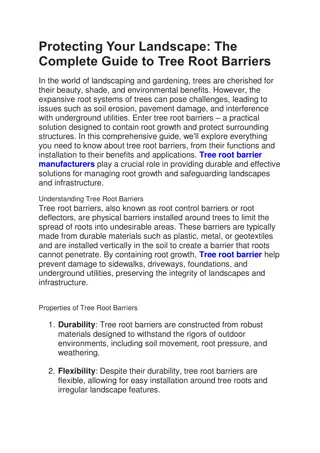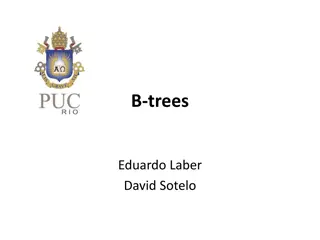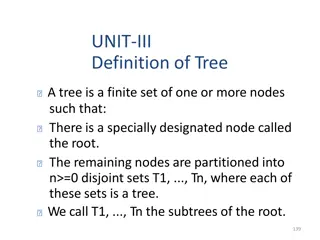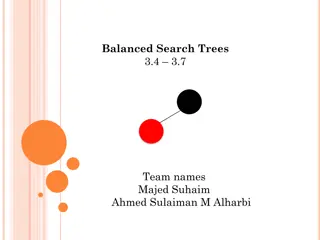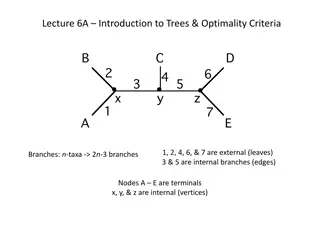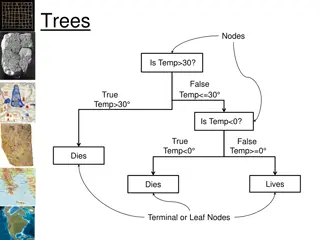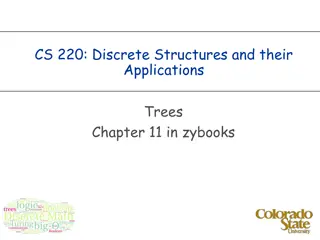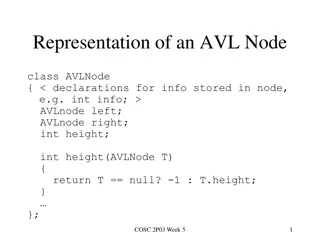Expression Tree Construction: Building Fully Parenthesized Expression Trees
In the process of building expression trees, nodes are inserted based on operators and operands, creating a fully parenthesized expression. The construction involves parsing the expression, inserting new nodes as tokens are examined, and linking nodes accordingly. By following the steps for handling operators, parentheses, and operands, a proper expression tree can be generated.
Download Presentation

Please find below an Image/Link to download the presentation.
The content on the website is provided AS IS for your information and personal use only. It may not be sold, licensed, or shared on other websites without obtaining consent from the author.If you encounter any issues during the download, it is possible that the publisher has removed the file from their server.
You are allowed to download the files provided on this website for personal or commercial use, subject to the condition that they are used lawfully. All files are the property of their respective owners.
The content on the website is provided AS IS for your information and personal use only. It may not be sold, licensed, or shared on other websites without obtaining consent from the author.
E N D
Presentation Transcript
Binary Tree Application Build Expression Tree Heaps Revised based on textbook author s notes.
String Representation The result was not correct because required parentheses were missing. Can easily create a fully parenthesized expression. ((8 * 5) + (9 / (7 - 4))) Class activity to implement this __str__() method. 2
Expression Tree Implementation exptree.py class ExpressionTree : # ... def _build_string( self, tree_node ): # If the node is a leaf, it's an operand. if tree_node.left is None and tree_node.right is None : return str( tree_node.element ) # Otherwise, it's an operator. else : exp_str = '(' exp_str += self._build_string( tree_node.left ) exp_str += str( tree_node.element ) exp_str += self._build_string( tree_node.right ) exp_str += ')' return exp_str 3
Expression Tree Construction An expression tree is constructed by parsing the expression and examining the tokens. New nodes are inserted as the tokens are examined. Each set of parentheses will consist of: an interior node for the operator two children either single valued or a subexperssion. 4
Expression Tree Construction For simplicity, we assume: the expression is stored in a string with no white space. the expression is valid and fully parenthesized. each operand will be a single-digit or single-letter variable. the operators will consist of +, -, *, /, % 5
Expression Tree Construction Consider the expression (8*5) The process starts with an empty root node set as the current node: The action at each step depends on the current token. 6
Expression Tree Construction When a left parenthesis is encountered: (8*5) a new node is created and linked as the left child of the current node. descend down to the new node. 7
Expression Tree Construction When an operand is encountered: (8*5) the data field of the current node is set to contain the operand. move up to the parent of current node. 8
Expression Tree Construction When an operator is encountered: (8*5) the data field of the current node is set to the operator. a new node is created and linked as the right child of the current node. descend down to the new node. 9
Expression Tree Construction Another operand is encountered: (8*5) 10
Expression Tree Construction When a right parenthesis: (8*5) move up to the parent of the current node. 11
Expression Example #2 ((2*7)+8) Consider another expression: 12
Expression Tree Implementation exptree.py class ExpressionTree : # ... def _build_tree( self, exp_str ): # Build a queue containing the tokens from the expression. expQ = Queue() for token in exp_str : expQ.enqueue( token ) # Create an empty root node. self._exp_tree = _ExpTreeNode( None ) # Call the recursive function to build the tree. self._rec_build_tree( self._exp_tree, expQ ) 13
Expression Tree Implementation exptree.py class ExpressionTree : # ... def _rec_build_tree( self, cur_node, expQ ): # Extract the next token from the queue. token = expQ.dequeue() # See if the token is a left paren: '(' if token == '(' : cur_node.left = _ExpTreeNode( None ) build_treeRec( cur_node.left, expQ ) # The next token will be an operator: + - / * % cur_node.data = expQ.dequeue() cur_node.right = _ExpTreeNode( None ) self._build_tree_rec( cur_node.right, expQ ) # The next token will be a ), remove it. expQ.dequeue() # Otherwise, the token is a digit. else : cur_node.element = token Run testexptree.py in 28_ExpressionTree/ 14
Heaps A heap is a complete binary tree in which the nodes are organized based on their data values. heap order property how the nodes in a heap or arranged. heap shape property as a complete binary tree. 15
Heap property, examples For each non-leaf node V, max-heap: the value in V is greater than the value of its two children. min-heap: the value in V is smaller than the value of its two children. 16
Heap Operations The heap is a specialized structure with limited operations. Insert an element into the heap. Remove the element from root node. 17



